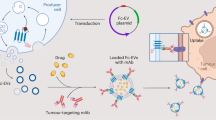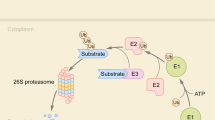Abstract
βig-h3 is a transforming growth factor-β (TGF-β)-induced cell-adhesive molecule and has an RGD sequence at its C-terminus. A previous report suggested that βig-h3 normally undergoes carboxy-terminal processing that results in the loss of the RGD sequence. RGD peptides appear to play various roles in cell function. Here we show that the RGD peptides released from βig-h3 may facilitate TGF-β-induced apoptosis. We found that carboxy-terminal cleavage of βig-h3 occurred after its secretion, and that overexpression of the wild-type βig-h3 induced apoptosis, unlike the C-terminal deleted but RGD-containing mutant βig-h3, which is resistant to C-terminal processing. The βig-h3-induced apoptosis was abolished by either deletion of the RGD sequence or mutation of RGD to RAE. Synthetic peptides of ERGDEL and GRGDSP derived from βig-h3 and fibronectin, respectively, also induced apoptosis, unlike ERGEEL and GRGESP. Culture supernatants of cells overexpressing βig-h3 filtered to isolate molecules smaller than 3 kDa also induced apoptosis. A fusion protein composed of the N-terminal 100 amino acids of fibronectin and the RGD-containing C-terminal part of βig-h3 was also subjected to C-terminal cleavage and overexpression resulted in apoptosis. The anti-βig-h3 antibody blocks TGF-β-induced apoptosis. Thus, βig-h3 may be important in regulating cell apoptosis by providing soluble RGD peptides.
This is a preview of subscription content, access via your institution
Access options
Subscribe to this journal
Receive 50 print issues and online access
$259.00 per year
only $5.18 per issue
Buy this article
- Purchase on Springer Link
- Instant access to full article PDF
Prices may be subject to local taxes which are calculated during checkout








Similar content being viewed by others
References
Atfi A, Buisine M, Mazars A and Gespach C . (1997). J. Biol. Chem., 272, 24731–24734
Buckley CD, Pilling D, Henriquez NV, Parsonage G, Threlfall K, Scheel-Toellner D, Simmons DL, Akbar AN, Lord JM and Salmon M . (1999). Nature, 397, 534–539.
Chen RH and Chang TY . (1997). Cell Growth Differ., 8,821–827.
Choi KS, Eom YW, Kang Y, Ha MJ, Rhee H, Yoon JW and Kim SJ . (1999). J. Biol. Chem., 274, 31775–31783.
Dieudonne SC, Kerr KM, Xu T, Sommer B, DeRubeis AR, Kuznetsov SA, Kim IS, Robey PG and Young MF . (1999). J. Cell. Biochem., 76, 231–243.
Epstein FH . (2000). New. Eng. J. Med., 342, 1350–1358.
Frisch SM and Francis HJ . (1994). J. Cell. Biol., 124, 619–626.
Genini M, Schwalbe P, Scholl FA and Schäfer BW . (1996). Int. J. Cancer, 66, 571–577.
Hishikawa K, Oemar BS, Tanner FC, Nakaki T, Lüscher TF and Fujii T . (1999). J. Biol. Chem., 274, 37461–37466.
Inayat-Hussain SH, Conet C, Cohen GM and Cain K . (1997). Hepatology, 25, 1516–1526.
Kawamoto T, Noshiro M, Shen M, Nakamasu K, Hashimoto K, Kawashima-Ohya Y, Gotoh O and Kato Y . (1998). Biochem. Biophys. Acta, 1395, 288–292.
Kim JE, Kim EH, Han EH, Park RW, Park IH, Jun SH, Kim JC, Young MF and Kim IS . (2000a). J. Cell. Biochem., 77, 169–178.
Kim JE, Kim SJ, Lee BH, Park RW, Kim KS and Kim IS . (2000b). J. Biol. Chem., 275, 30907–30915.
Kim JE, Park RW, Choi JY, Bae YC, Kim KS, Joo CK and Kim IS . (2002). Invest. Ophthalmol. Vis. Sci., 43, 656–661.
Lafon C, Mathieu C, Guerrin M, Pierre O, Vidal S and Valette A . (1996). Cell Growth Differ., 7, 1095–1104.
LeBaron RG, Bezverkov KI, Zimber MP, Pavele R, Skonier J and Purchio AF . (1995). J. Invest. Dermatol., 104, 844–849.
Munier FL, Korvatska E, Djemai S, LePaslier D, Zografos L, Pescia G and Schorderet DF . (1997). Nat. Genet., 15, 247–251.
Ohno S, Noshiro M, Makihira S, Kawamoto T, Shen M, Yan W, Kawashim-Ohya Y, Fujimoto K, Tanne K and Kato Y . (1999). Biochem. Biophys. Acta, 1451, 196–205.
Perlot RL, Shapiro IM, Mansfield K and Adams CS . (2002). J. Bone Miner. Res., 17, 66–76.
Pierschbacher MD and Ruoslahti E . (1984). Nature, 309, 30–33.
Rawe IM, Zhan Q, Burrows R, Bennett K and Cintron C . (1997). Invest. Ophthalmol. Vis. Sci., 38, 893–900.
Ruoslahti E . (1996). Annu. Rev. Cell Dev. Biol., 12, 697–715.
Sánchez A, Alvarez AM, Benito M and Farbregat I . (1996). J. Biol. Chem., 271, 7416–7422.
Schenker T and Trueb B . (1998). Exp. Cell Res., 239, 161–168.
Skonier J, Bennett K, Rothwell V, Kosowski S, Plowman G, Wallace P, Edelhoff S, Disteche C, Neubauer M, Marquardt H, Rodgers J and Purchio AF . (1994). DNA Cell Biol., 13, 571–584.
Skonier J, Neubauer M, Madisen L, Bennett K, Plowman GD and Purchio AF . (1992). DNA Cell Biol., 11, 511–522.
Acknowledgements
This work was supported by a program of the National Research Laboratory (M10104000036-01J0000-01610).
Author information
Authors and Affiliations
Corresponding author
Rights and permissions
About this article
Cite this article
Kim, JE., Kim, SJ., Jeong, HW. et al. RGD peptides released from βig-h3, a TGF-β-induced cell-adhesive molecule, mediate apoptosis. Oncogene 22, 2045–2053 (2003). https://doi.org/10.1038/sj.onc.1206269
Received:
Revised:
Accepted:
Published:
Issue Date:
DOI: https://doi.org/10.1038/sj.onc.1206269
Keywords
This article is cited by
-
Inhibitory functions of cornuside on TGFBIp-mediated septic responses
Journal of Natural Medicines (2022)
-
Suppressive functions of collismycin C in TGFBIp-mediated septic responses
Journal of Natural Medicines (2020)
-
Epigenetic silencing of TGFBI confers resistance to trastuzumab in human breast cancer
Breast Cancer Research (2019)
-
Dysregulation of the MiR-449b target TGFBI alters the TGFβ pathway to induce cisplatin resistance in nasopharyngeal carcinoma
Oncogenesis (2018)
-
Suppressive effects of zingerone on TGFBIp-mediated septic responses
Archives of Pharmacal Research (2018)



